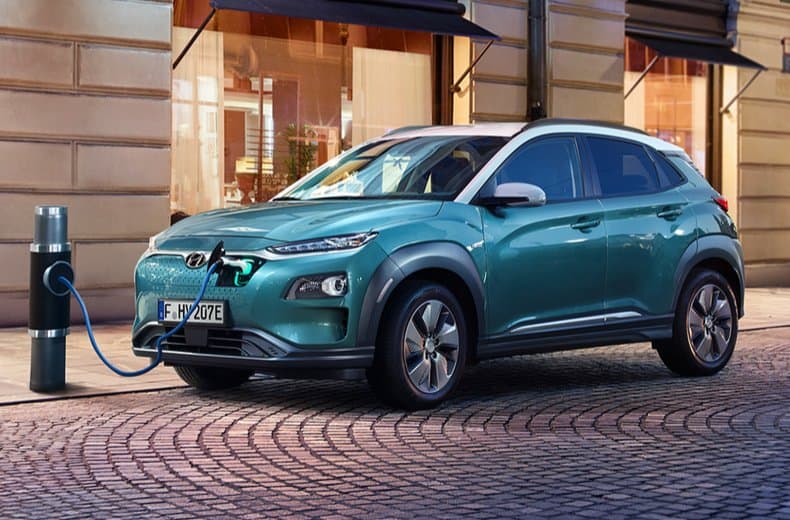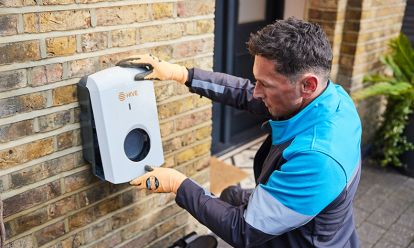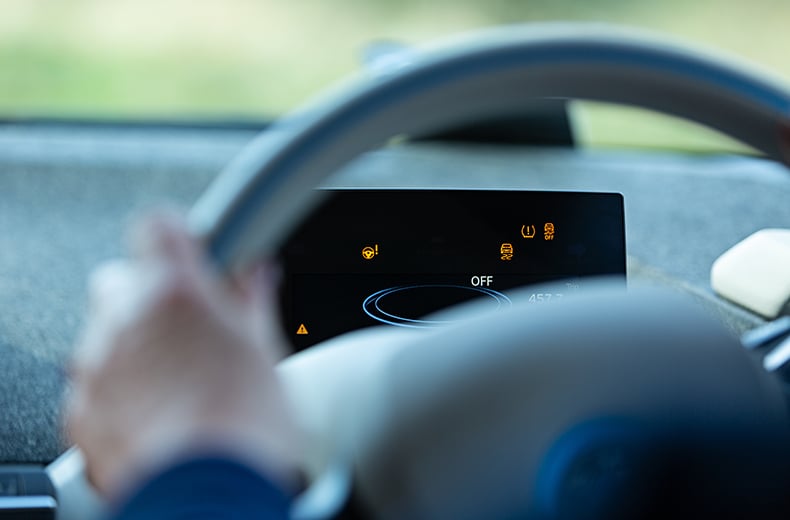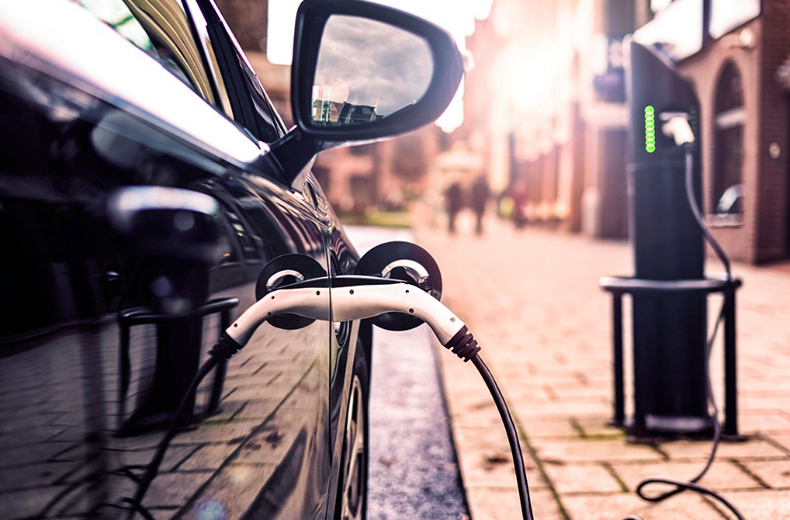According to figures released by the Society of Motor Manufacturers and Traders (SMMT), sales of pure electric vehicles are consistently up when compared to a year ago.1
While their numbers remain relatively low compared to petrol and diesel cars, electric vehicle (EV) sales have started to grow rapidly. The RAC is also now the number one provider of EV breakdown cover in the UK.
Along with zero tailpipe emissions, rising interest is also being driven by increased affordability, widespread availability of charging points, the threat of pollution charges in city centres, scrappage incentives and government grants.
So, are electric cars as green as they claim to be? We examine the evidence with help from the Energy Saving Trust.
Zero (tailpipe) emissions

From the moment an EV hits the road, it emits no tailpipe emissions. However, it still produces some degree of pollution from tyre and brake particles. In truth, though, the real environmental impact occurs before an electric car has even left the factory floor.
A report by the European Environment Agency (EEA) highlights that emissions from battery electric vehicle (BEV) production are generally higher than those created by building an internal combustion-engined (ICE) vehicle.
One study suggests that CO2 emissions from electric car production are 59% higher than those for the production of ICE vehicles.2
The greater emissions largely come from the battery manufacturing process, something the EEA suggests could be improved to incorporate increased use of renewable energies.
Companies such as Volkswagen and Volvo are now producing their electric cars in carbon-neutral ways, and more manufacturers will follow the same path in future.3/4
Even so, once an electric vehicle begins its life on the roads, the bulk of its emissions have already been produced. With combustion engines, a long period of tailpipe emissions is just beginning.
Install a home charging point
Going electric? Installing a home charging point makes owning an electric car so much easier and cheaper.


Battery production concerns
Most car batteries are made in China, South Korea and Japan, where the use of carbon in electricity production is relatively high, although more battery production facilities are starting to appear in Europe and the UK.
An EEA report found that in China, 35-50% of total EV manufacturing emissions arise from electricity consumption for battery production. These emissions are up to three times higher than in the United States.
In China, the proportion of renewable energy in the electricity mix is projected to rise sharply between now and 2025.
If electricity was generated by wind power alone, China would see a 50% drop in emissions from the production phase compared with the current EU electricity grid mix.6
Reducing worldwide carbon intensity by 30% would see a 17% reduction in greenhouse gas emissions from battery production by 2030.
Lithium batteries found in electric cars tend to be made up of base metals such as copper, aluminium and iron. Other critical raw materials (CRMs) with high economic importance and high-risk supply feature more in electric vehicle production than ICE vehicle production, and require energy-intensive extraction.
Improved energy production techniques and more advanced battery technology will result in less reliance on CRMs. This means that electric cars will get greener as the means to produce and power them start to leave less of an environmental impact.
Is there enough lithium and other rare metals to meet demand for battery production?
It is reported that the global supply of lithium-ion batteries is struggling to keep up with the increased demand from EV manufacturers.
However, this is generally seen as a short-term problem – perhaps reflecting an industry caught off-guard by the rapid increase in demand for EVs and batteries.
Globally, both battery production and the production of lithium and other precious metals is being ramped up quickly.
In 2018, lithium, cobalt, graphite and nickel prices, all of which are used in EV production, all fell back significantly after price spikes in 2016 and 2017, indicating that the markets are confident in the long-term supply of these metals.7
However, other battery technologies which use little or no rare earth materials, such as sodium-ion and lithium iron phosphate, are being developed to transition away from lithium-ion, saving fragile ecosystems.
How long will the battery last?

A well-maintained, modern electric car should be able to achieve 150,000 miles and beyond before the battery begins to lose capacity, although this figure will reduce if a rapid-charger has been the predominant method of charging.
Find out everything you need to know about electric car charging here.
At some point, EV owners will be faced with recycling or replacing the battery – likely to then cost far more than the value of the vehicle.
Currently there is no standardised process for recycling batteries, but the benefits make a considerable difference to electric vehicles’ green credentials.
Reports8 suggest that material recovery can lead to a reduction in energy of 6-56% and a 23% reduction of greenhouse gases, compared with virgin material production.
Car manufacturers have started to act. Volkswagen introduced a scheme in 2019 which it believes will see 97% of all the raw materials used in new EV batteries reused by 20409.
A standardised recycling technique and testing of second-use applications for these batteries has the potential to significantly reduce the environmental impact of their production.
Renewable power is key

Once production is over, an electric car is only as clean as the power it uses to keep it moving.
Until 100% of EVs run on 100% renewable power, the electricity source will remain a thorn in the side of an EV’s environmental merits.
Crucially though, an electric vehicle has the potential to be 100% green, at least from a driving and power source perspective. And the good news is that energy production is reaching a significant turning point.
In May 2019, the UK clocked up its first coal-free fortnight.
In the third quarter of 2019, wind farms, solar panels, biomass and hydro plants generated more electricity than the combined output from coal, oil and gas power stations, and ‘renewables’ accounted for a record 47% of UK generation in the first quarter of 2020.8/11
By 2050, solar power is set to generate the largest share of electricity in the UK.
Will the future be electrified?
The National Grid predicts there will be 36 million electric vehicles on UK roads by 2040 – a figure revealed before the government’s plan to bring the ban on new petrol and diesel sales forward to 2030.
Battery electric cars appear to be the future of mass transportation. For a while, electric power was seen as neck-and-neck with hydrogen in the race to win mainstream appeal, but EVs are now firmly in the lead.
While the likes of the Toyota Mirai and Honda Clarity are undoubtedly impressive, they are sold in very small numbers. Hydrogen may have a strong future in Japan, but only via large-scale investment from the government.
Every major car manufacturer now has plans to produce electric-only cars from 2030 or sooner.12
RAC Breakdown Cover
Join the RAC and get breakdown cover. Our patrols fix 4 out of 5 vehicles on the spot, with repairs done in just 30 minutes on average.


Electric vehicle charge demand

According to Zap-Map, there are more than 46,000 EV charging connectors in the UK, across 17,000 locations.
The SMMT has predicted that 2.3 million charging points will be needed in the UK by 2030, which equates to installing 700 per day until then.
Of course, some degree of home charging will be required if infrastructure is to cope with the increased number of electric cars.
From 2022, all new UK homes and buildings – such as supermarkets and workplaces, in addition to those undergoing major renovation – must have electric vehicle charging points installed.14
- Electric car leasing explained – EV financing vs buying
- Cheapest electric cars – top 12 used and new EVs available now
- Electric vehicle range – how far can I drive in an EV?
EV charging impact on the national grid
Electricity suppliers are working hard to forecast the extra demand that a greater number of EVs will need – and are generally confident they can meet it.
The scale of the challenge is highlighted by UK Power Networks, which estimated it will have 4.1 million EV charging from its networks by 2030.15
Part of the answer will come from the provision of additional generating capacity where it is required. Innovative solutions such as smart charging and vehicle-to-grid (V2G) will also have a major part to play in ensuring electricity supply will continue to meet demand.
However, the National Grid is confident it can meet the forecasted need.16
What is smart charging?
Smart charging involves charging infrastructure and electricity tariffs that allow EV owners (fleet or private) to benefit from lower costs if they charge at times when there is surplus electricity available.
Unlike Economy 7 and similar pricing tariffs, which have offered customers cheaper electricity during certain fixed night-time hours, smart charging involves real-time pricing information, based on supply and demand within the network. This determines whether charging begins.
For example, a user that has opted for a smart tariff might return home at 6pm and plug in an EV, but it may not start charging until later that evening when demand for electricity has fallen and the supplier has reduced its prices accordingly.
Smart charging benefits EV operators as they pay less for their electricity, but also benefits electricity suppliers because reducing peak electricity demand could reduce the required investment in new generating capacity and network reinforcement.
What is vehicle-to-grid or V2G?
Vehicle-to-grid takes the logic of smart charging one step further because at times of high electricity demand, electricity will flow out of electric cars’ batteries to help meet the high demand.
As with smart charging, V2G tariffs will be optional and will work through price incentives.
EV whole lifecycle impact
Vehicle ‘lifecycle analyses’ – taking account of all the emissions from the mining of ores, the manufacture of vehicles and batteries, and the in-use energy consumption of petrol, diesel or electricity – show large overall CO2 savings for EVs compared to conventional vehicles.
The British Government’s key 2018 publication The Road to Zero stated that EVs ‘have substantially lower greenhouse gas emissions than conventional vehicles, even when taking into account the electricity source and the electricity used for battery production. Assuming the current UK energy mix, battery electric vehicles produce the lowest greenhouse gas emissions of all the energy sources and fuels assessed, irrespective of vehicle type and operation’.17
The report estimated that in 2018 an electric car in the UK had total associated greenhouse gas emissions 66% lower than a petrol car and 60% lower than a diesel car.
It also estimated that by 2050, emissions from UK electricity generation would fall by 90% because renewables will dominate generation. Emissions associated with EV use will fall in parallel.
So are electric vehicles better for the environment?
The evidence says they are. Locally, there's little doubt electric cars make our urban areas cleaner and quieter, too.
Once on the road, they’re also responsible for much lower emissions than cars powered by fossil fuels.
The challenge now is to further reduce the emissions produced through more climate-neutral EV manufacturing and greener energy production.
As electric cars become more widespread, cleaner energy generation, better recycling schemes and improvements to battery technology are needed before we feel the full benefit of their green potential.
The RAC is leading the way when it comes to supporting drivers in the switch to electric vehicles.
An ever-increasing number of our patrol vans have built-in emergency mobile charging systems capable of giving an out-of-charge electric car enough power to be driven a short distance home or to a working chargepoint, while our All-Wheels-Up recovery system allows our patrols to safely rescue electric cars with no need for a flatbed.
Find out more about the RAC’s electric car breakdown cover and EV insurance options today. Rest assured, the RAC are here to also help with any car repairs through our mobile mechanics and the RAC approved garage network.
Return to the RAC Drive Electric cars hub
Read our guides on choosing, charging and running an electric car.

RAC Breakdown Cover
Limited Time Offer
*£7 a month for new, single vehicle Basic cover. ^For 1 nominated vehicle when added to Extra or Complete cover. New customers only. Ends 29/04/24. 7am.

1 https://www.smmt.co.uk/vehicle-data/evs-and-afvs-registrations/
2 https://www.sciencedirect.com/science/article/pii/S1876610217309049
3 https://www.volkswagen.co.uk/en/electric-and-hybrid/vision/leaders-in-electric/start-of-production-on-the-id4.html
4 https://electrek.co/2021/05/26/volvo-achieves-companys-first-climate-neutral-car-plant/
5 https://www.eea.europa.eu/highlights/eea-report-confirms-electric-cars
6 https://www.eea.europa.eu/highlights/eea-report-confirms-electric-cars
7 https://seekingalpha.com/article/4269216-battery-shortages-already-problem-electric-car-waiting-lists-becoming-norm
8 https://www.eea.europa.eu/publications/electric-vehicles-from-life-cycle
9 https://www.volkswagen.co.uk/en/electric-and-hybrid/sustainability/electric-car-battery-recycling.html
10 https://www.carbonbrief.org/analysis-uk-renewables-generate-more-electricity-than-fossil-fuels-for-first-time
11 https://www.edie.net/news/10/Renewables-accounted-for-record-47--of-UK-generation-in-first-quarter-of-2020/
12 https://www2.deloitte.com/content/dam/insights/us/articles/22869-electric-vehicles/figures/Fig-05.png
13 https://www.cityam.com/uk-must-install-700-electric-vehicle-charge-points-a-day-to-hit-2030-target/
14 https://www.gov.uk/government/news/pm-to-announce-electric-vehicle-revolution
15 https://www.fleetnews.co.uk/news/latest-fleet-news/fleet200-news/2019/04/10/smart-options-needed-to-help-electricity-network-cope-with-ev-uptake
16 https://www.autocar.co.uk/car-news/advice-electric-cars/how-national-grid-will-work-electric-cars
17 https://assets.publishing.service.gov.uk/government/uploads/system/uploads/attachment_data/file/739460/road-to-zero.pdf













